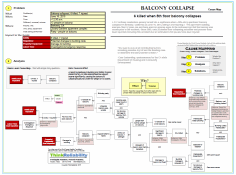By Kim Smiley
A 21st birthday celebration quickly turned into a nightmare when a fifth-story apartment balcony collapsed in Berkeley, California on June 16, 2015, killing 6 and injuring 7. The apartment building was less than 10 years old and there were no obvious signs to the untrained eye that the balcony was unsafe prior to the accident.
 The balcony was a cantilevered design attached to the building on only one side by support beams. A report by Berkeley’s Building and Safety Division stated that dry rot had deteriorated the support beams significantly, causing the balcony to catastrophically fail under the weight of 13 bodies.
The balcony was a cantilevered design attached to the building on only one side by support beams. A report by Berkeley’s Building and Safety Division stated that dry rot had deteriorated the support beams significantly, causing the balcony to catastrophically fail under the weight of 13 bodies.
Dry rot is decay caused by fungus and occurs when wood is exposed to water, especially in spaces that are not well-ventilated. The building in question was built in 2007 and the extensive damage to the support beam indicates that there were likely problems with the water-proofing done during construction of the balcony. Initial speculation is that the wood was not caulked and sealed properly when the balcony was built, which allowed the wood to be exposed to moisture and led to significant dry rot. However, the initial report by the Building and Safety Division did not identify any construction code violations, which raises obvious questions about whether the codes are adequate as written.
As a short-term solution to address potential safety concerns, the other balconies in the building were inspected to identify if they were at risk of a similar collapse so they could be repaired. As a potential longer-term solution to help reduce the risk of future balcony collapses in Berkeley as a whole, officials proposed new inspection and construction rules this week. Among other things, the proposed changes would require balconies to include better ventilation and require building owners to perform more frequent inspections. Only time will tell if proposed code changes will be approved by the Berkeley City Council, but something should be changed to help ensure public safety.
Finding a reasonable long-term solution to this problem is needed because balconies and porches are susceptible to rot because they are naturally exposed to weather. Deaths from balcony failures are not common, but there have been thousands of injuries. Since 2003, only 29 deaths from collapsing balconies and porches have been reported in the United States (including this accident), but an estimated 6,500 people have been injured.
Click on “Download PDF” above to see a Cause Map, a visual format of root cause analysis, of this accident. A Cause Map lays out all the causes that contributed to an issue to show the cause-and-effect relationships.
